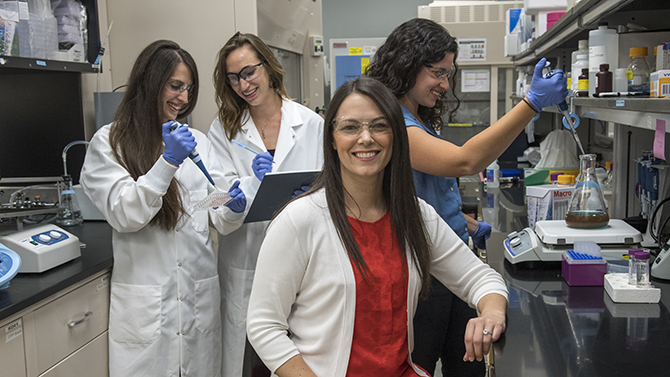


Nanocarrier design
Photo by Kathy F. Atkinson September 28, 2016
Research to shed light on interactions between nanocarriers, biological systems
The discovery of microRNAs (miRNAs) in the 1990s brought a new dimension to the understanding of complex gene regulatory networks in both humans and animals.
These small noncoding molecules are promising tools in the development of new therapies to fight disease because, upon delivery into diseased cells, they can suppress the expression of specific genes that drive disease progression.
However, “naked” miRNAs are not suitable for clinical use due to their poor stability, limited circulation half-life, and inability to enter cells without a transfection agent, so researchers have begun to incorporate them into nanoparticle-based carriers, or “nanocarriers,” to facilitate their delivery to desired locations and cells within the body where they can do their work.
“While some progress has been made in this technology, there is substantial room for improvement, as evidenced by the fact that only a single miRNA nanocarrier has entered clinical trials,” says Emily Day, assistant professor in the Department of Biomedical Engineering at the University of Delaware, and leader of the Laboratory for Engineered Nanotherapeutics.
“I thought it was time to take a step back and identify the design rules for miRNA nanocarriers that will give us the best response and therapeutic effect,” she says. “We want to determine the principles underlying the interactions between these nanocarriers and various biological systems so that we can ultimately match carriers to diseases.”
Day recently received a five-year, $1.9-million grant from the National Institutes of Health to address this issue.
Specifically, she plans to elucidate how the physical and chemical properties of miRNA nanocarriers influence five outcomes related to the challenges associated with delivering miRNAs to precise tissues and cells within the body: stability, cell uptake and intracellular trafficking, gene regulation potency, biodistribution, and ability to halt the progression of diseases, including breast cancer and osteoporosis.
By studying these five outcomes, Day hopes to increase understanding of the effects of miRNA nanocarriers on the body as well as the effects of the body on the nanocarriers.
“We really don’t know what we’ll find,” she says. “It could be that one design works well for a whole range of diseases. Or the opposite may be true, that a different nanocarrier is required for optimal treatment of every disease, or even different subtypes of the same disease.”
“Either way, we will gain valuable information that will enable precision medicine to become even more precise, with therapies delivered only to diseased cells and leaving healthy cells relatively unaffected,” she adds. “By studying how specific features of nanoparticle-based miRNA carriers influence their ability to enter specific tissues and cells and regulate gene expression, we hope to provide enhanced therapeutic strategies that will ultimately improve patient health and wellness.”
Day points out that while the proposed work focuses specifically on miRNA, the findings should be applicable to other types of RNA therapies, the goal of which is to fight disease by turning on and off the genes that regulate proteins in the body’s cells.
About the grant
The project, “Maximizing the Delivery and Efficacy of miRNA Therapeutics Through Nanocarrier Design,” is supported by NIH grant 1R35GM119659-01.
Funding for the work was awarded through the NIH MIRA (Maximizing Investigators’ Research Award, or R35) program. MIRA provides support for the research in an investigator’s laboratory that falls within the mission of the National Institute of General Medical Science (NIGMS). The goal of MIRA is to increase the efficiency and efficacy of NIGMS funding by providing investigators with greater stability and flexibility, thereby enhancing scientific productivity and the chances for important breakthroughs. The program will also help distribute funding more widely among the nation’s highly talented and promising investigators.
Day is partnering with Ken van Golen and Randy Duncan in UD’s Department of Biological Sciences on the project. Van Golen brings expertise in cancer research, while Duncan is an expert in bone biology.
Contact Us
Have a UDaily story idea?
Contact us at ocm@udel.edu
Members of the press
Contact us at 302-831-NEWS or visit the Media Relations website

